fuel type Hyundai Coupe 2002 Owner's Manual
[x] Cancel search | Manufacturer: HYUNDAI, Model Year: 2002, Model line: Coupe, Model: Hyundai Coupe 2002Pages: 140, PDF Size: 1.45 MB
Page 39 of 140
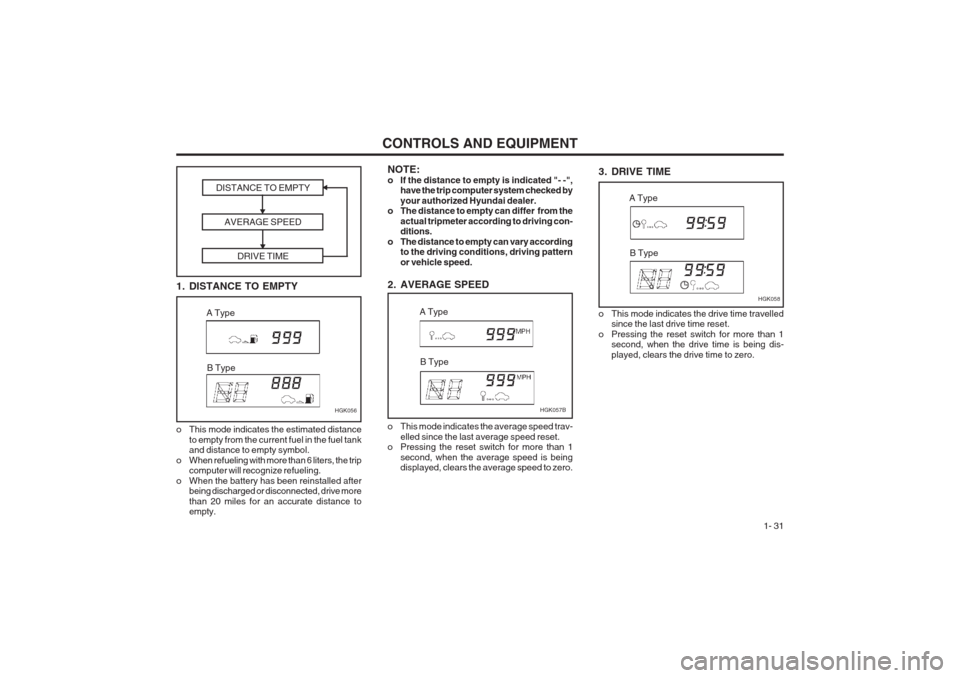
CONTROLS AND EQUIPMENT1- 31
3. DRIVE TIME
HGK058
A Type
B Type
NOTE:
o If the distance to empty is indicated "- -", have the trip computer system checked byyour authorized Hyundai dealer.
o The distance to empty can differ from the
actual tripmeter according to driving con- ditions.
o The distance to empty can vary according to the driving conditions, driving pattern or vehicle speed.
2. AVERAGE SPEED
o This mode indicates the average speed trav- elled since the last average speed reset.
o Pressing the reset switch for more than 1
second, when the average speed is being displayed, clears the average speed to zero. HGK057B
A Type
B Type
1. DISTANCE TO EMPTY DISTANCE TO EMPTY
AVERAGE SPEED DRIVE TIME
o This mode indicates the estimated distanceto empty from the current fuel in the fuel tank and distance to empty symbol.
o When refueling with more than 6 liters, the trip computer will recognize refueling.
o When the battery has been reinstalled after being discharged or disconnected, drive more than 20 miles for an accurate distance to empty. HGK056
A Type
B Type
o This mode indicates the drive time travelled since the last drive time reset.
o Pressing the reset switch for more than 1 second, when the drive time is being dis- played, clears the drive time to zero.
Page 87 of 140

DRIVING YOUR HYUNDAI 2- 13
NOTE:
o The total gross vehicle weight with trailer
must not exceed the Gross Vehicle WeightRating (GVWR) shown on the vehicle identification plate (see page 8-1). The total gross vehicle weight is the com- bined weight of the vehicle, driver, all passengers and their luggage, cargo, hitch, trailer tongue load and other op- tional equipment.
o The front or rear axle weight must not exceed the Gross Axle Weight Rating(GAWR) shown on the vehicle identifica- tion plate (see page 8-1). it is possible that your towing package does not ex- ceed the GVWR but exceeds the GAWR. Improper trailer loading and/or too much luggage in the boot can overload the rear axle. Redistribute the load and check the axle weight again.
sure rather than as a result of the distancestowed. The inside walls of the tyres should be inspected along with the outside walls for crack- ing and damage. The trailer wheel nut torque must be checked on a regular basis, preferably before each towing session. The trailer hitch and the safety catch mecha- nism must be maintained in good working or- der. The trailer break away cable or chain should be inspected for damage and should be attached to the vehicle towing attachment each and every time the trailer is hitched to the vehicle. Whilst towing, the performance of the vehicle will be reduced in terms of acceleration, braking and handling due to the increased loads placed upon the vehicle. The driver should anticipate the change in characteristics and adjust the driving style in keeping with these changes. Care should be exercised when cornering and braking to prevent the outfit becoming uncon- trollable by reducing cornering speeds and al- lowing increased braking distances. The driver should exercise care to ensure that when pulling away from rest particularly on uphill gradients the clutch unit is not subjected to excessive slippage which will reduce the useful life of this component. Use of the "Over- drive Off" "2" and "L" positions when driving vehicles with automatic transmission will assist with braking performance when long down hill gradients are encountered. Improved accelera-tion performance will be available by selecting "Overdrive Off","2", or "1" depending upon road speed if it is found that the transmission unit makes an undesirable upshift whilst hill climb- ing or overtaking. The transmission unit should be operated in "D" with the Overdrive "On" under normal circumstances to enhance fuel economy and reduce noise and engine wear.
SSA2200DGross Axle Weight
Gross Vehicle Weight
CAUTION: The use of a badly loaded or overloadedtrailer may result in instability.This following specifications are recom- mended when towing a trailer. The loaded trailer weight or the Gross Train Weight must not exceed the values in the chart below. Maximum
Towable Weight
Trailer
1,212(550)
2,645(1,200) 3,086(1,400)
Lbs.(kg)
With Brake
Type1.6 L
2.0/2.7 L
Without Brake Type
Page 90 of 140
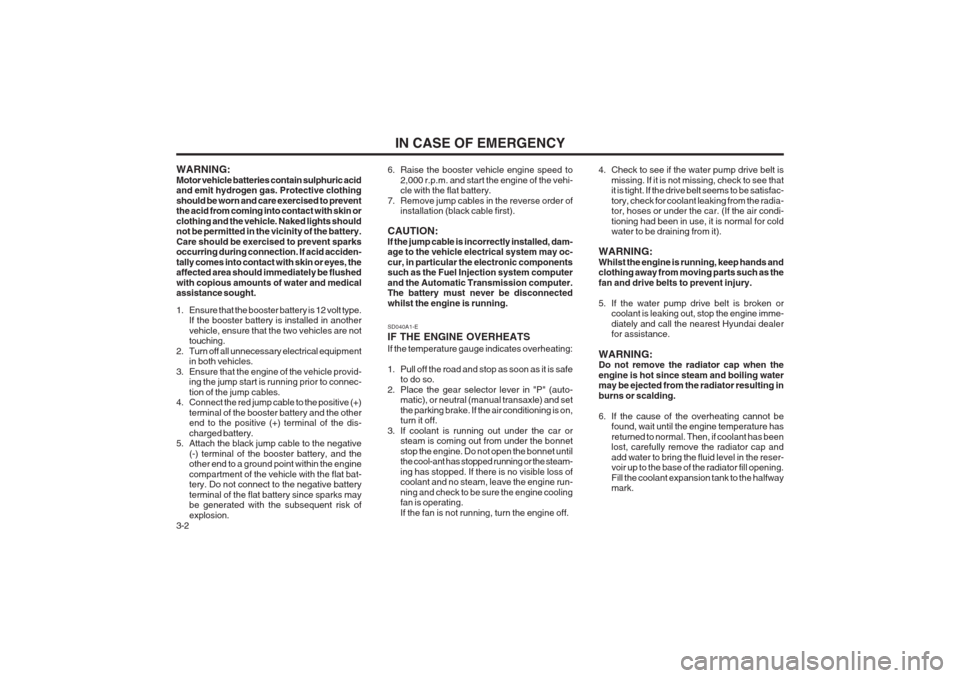
IN CASE OF EMERGENCY
3-2 4. Check to see if the water pump drive belt is
missing. If it is not missing, check to see that it is tight. If the drive belt seems to be satisfac- tory, check for coolant leaking from the radia- tor, hoses or under the car. (If the air condi- tioning had been in use, it is normal for cold water to be draining from it).
WARNING: Whilst the engine is running, keep hands and clothing away from moving parts such as the fan and drive belts to prevent injury.
5. If the water pump drive belt is broken or coolant is leaking out, stop the engine imme- diately and call the nearest Hyundai dealer for assistance.
WARNING:Do not remove the radiator cap when the engine is hot since steam and boiling water may be ejected from the radiator resulting in burns or scalding.
6. If the cause of the overheating cannot be found, wait until the engine temperature has returned to normal. Then, if coolant has been lost, carefully remove the radiator cap and add water to bring the fluid level in the reser- voir up to the base of the radiator fill opening. Fill the coolant expansion tank to the halfway mark.
WARNING: Motor vehicle batteries contain sulphuric acid and emit hydrogen gas. Protective clothing should be worn and care exercised to prevent the acid from coming into contact with skin or clothing and the vehicle. Naked lights should not be permitted in the vicinity of the battery. Care should be exercised to prevent sparks occurring during connection. If acid acciden- tally comes into contact with skin or eyes, the affected area should immediately be flushed with copious amounts of water and medical assistance sought.
1. Ensure that the booster battery is 12 volt type.
If the booster battery is installed in another vehicle, ensure that the two vehicles are not touching.
2. Turn off all unnecessary electrical equipment in both vehicles.
3. Ensure that the engine of the vehicle provid- ing the jump start is running prior to connec- tion of the jump cables.
4. Connect the red jump cable to the positive (+)
terminal of the booster battery and the other end to the positive (+) terminal of the dis- charged battery.
5. Attach the black jump cable to the negative
(-) terminal of the booster battery, and the other end to a ground point within the engine compartment of the vehicle with the flat bat- tery. Do not connect to the negative battery terminal of the flat battery since sparks may be generated with the subsequent risk of explosion. 6. Raise the booster vehicle engine speed to
2,000 r.p.m. and start the engine of the vehi- cle with the flat battery.
7. Remove jump cables in the reverse order of installation (black cable first).
CAUTION: If the jump cable is incorrectly installed, dam- age to the vehicle electrical system may oc- cur, in particular the electronic components such as the Fuel Injection system computer and the Automatic Transmission computer. The battery must never be disconnected whilst the engine is running. SD040A1-E IF THE ENGINE OVERHEATSIf the temperature gauge indicates overheating:
1. Pull off the road and stop as soon as it is safe to do so.
2. Place the gear selector lever in "P" (auto- matic), or neutral (manual transaxle) and set the parking brake. If the air conditioning is on, turn it off.
3. If coolant is running out under the car or steam is coming out from under the bonnet stop the engine. Do not open the bonnet until the cool-ant has stopped running or the steam- ing has stopped. If there is no visible loss of coolant and no steam, leave the engine run- ning and check to be sure the engine cooling fan is operating. If the fan is not running, turn the engine off.
Page 100 of 140
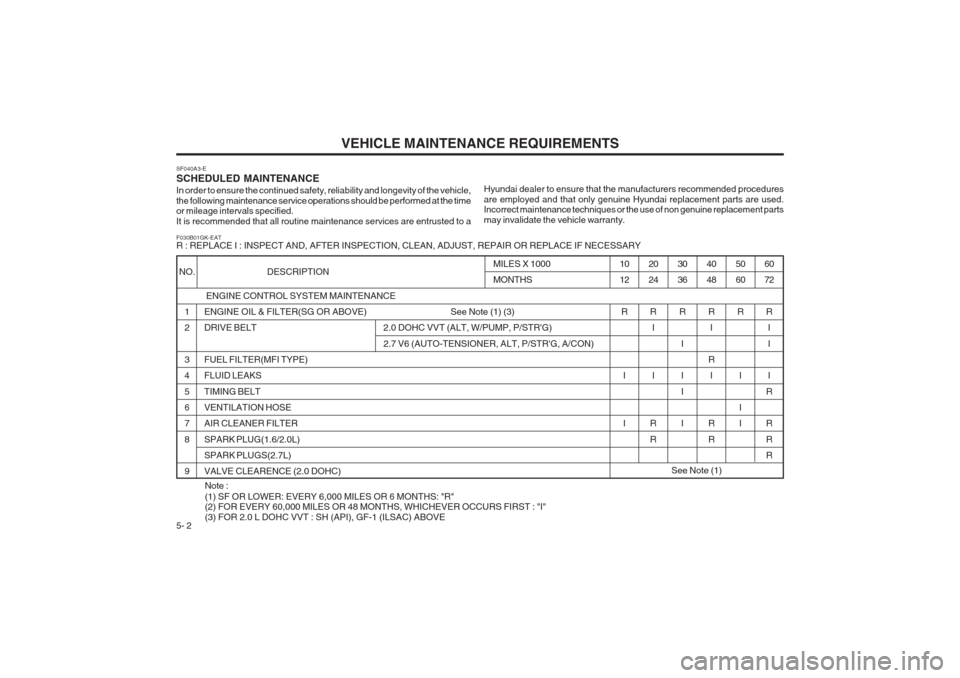
VEHICLE MAINTENANCE REQUIREMENTS
5- 2
SF040A3-E SCHEDULED MAINTENANCE In order to ensure the continued safety, reliability and longevity of the vehicle, the following maintenance service operations should be performed at the time or mileage intervals specified. It is recommended that all routine maintenance services are entrusted to a
Hyundai dealer to ensure that the manufacturers recommended proceduresare employed and that only genuine Hyundai replacement parts are used. Incorrect maintenance techniques or the use of non genuine replacement parts may invalidate the vehicle warranty.
F030B01GK-EAT R : REPLACE I : INSPECT AND, AFTER INSPECTION, CLEAN, ADJUST, REPAIR OR REPLACE IF NECESSARY
ENGINE CONTROL SYSTEM MAINTENANCE
ENGINE OIL & FILTER(SG OR ABOVE) See Note (1) (3)
DRIVE BELT 2.0 DOHC VVT (ALT, W/PUMP, P/STR'G) 2.7 V6 (AUTO-TENSIONER, ALT, P/STR'G, A/CON)
FUEL FILTER(MFI TYPE)FLUID LEAKS TIMING BELT VENTILATION HOSEAIR CLEANER FILTER SPARK PLUG(1.6/2.0L) SPARK PLUGS(2.7L)VALVE CLEARENCE (2.0 DOHC)
NO. DESCRIPTION60 72
R I I I
RR R R
5060
R
I I I
4048
R I
R I
R R
30 36
R I I I I
20 24
R I I
R R
10 12
R
I I
MILES X 1000 MONTHS
Note : (1) SF OR LOWER: EVERY 6,000 MILES OR 6 MONTHS: "R" (2) FOR EVERY 60,000 MILES OR 48 MONTHS, WHICHEVER OCCURS FIRST : "I" (3) FOR 2.0 L DOHC VVT : SH (API), GF-1 (ILSAC) ABOVE
1 2 3 4 5 67 8 9
See Note (1)
Page 134 of 140
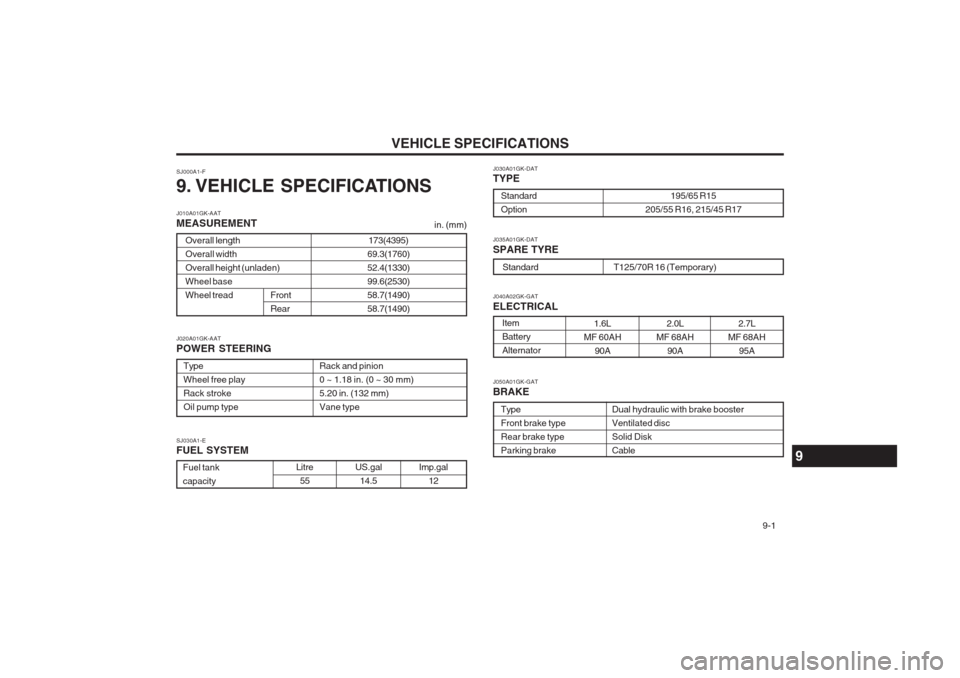
VEHICLE SPECIFICATIONS 9-1
Standard Option
SJ000A1-F
9. VEHICLE SPECIFICATIONS
Litre55
in. (mm)
173(4395)
69.3(1760) 52.4(1330)99.6(2530)58.7(1490)58.7(1490)
Rack and pinion 0 ~ 1.18 in. (0 ~ 30 mm)5.20 in. (132 mm)Vane type
9
J010A01GK-AAT MEASUREMENT J020A01GK-AAT POWER STEERING SJ030A1-E FUEL SYSTEM J030A01GK-DATTYPE J040A02GK-GAT ELECTRICAL
Item BatteryAlternator
Overall lengthOverall widthOverall height (unladen)Wheel baseWheel tread
FrontRear
TypeWheel free playRack strokeOil pump type
Fuel tankcapacity US.gal
14.5 Imp.gal
12 195/65 R15
205/55 R16, 215/45 R17
1.6L
MF 60AH 90A2.0L
MF 68AH 90A2.7L
MF 68AH 95A
J035A01GK-DAT SPARE TYRE
T125/70R 16 (Temporary)
Standard
Dual hydraulic with brake booster Ventilated discSolid DiskCable
J050A01GK-GAT BRAKE
Type Front brake typeRear brake typeParking brake
Page 138 of 140
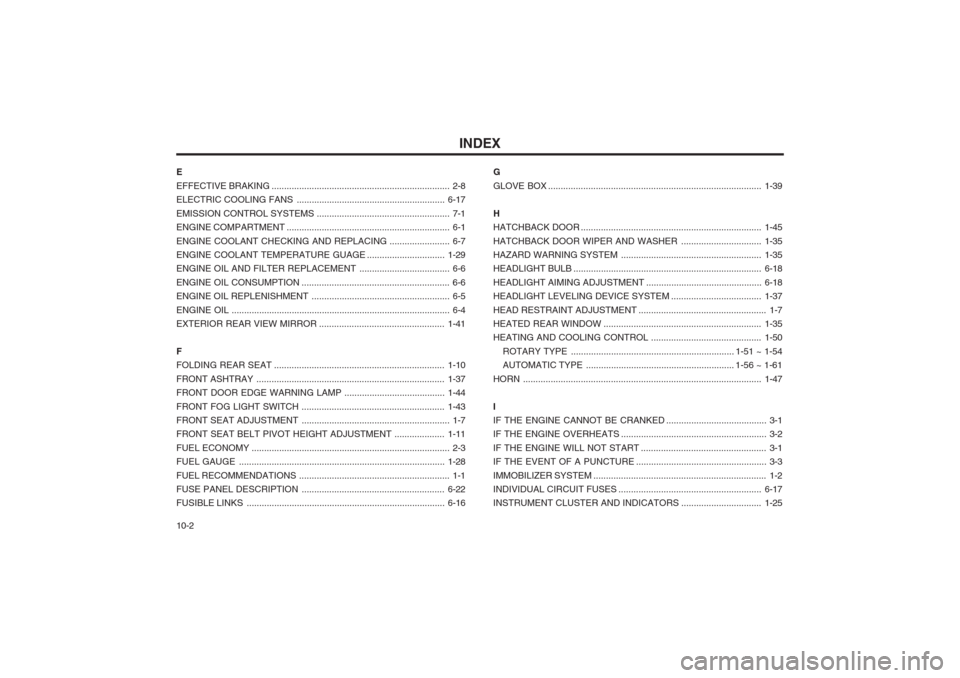
INDEX
10-2
E EFFECTIVE BRAKING
....................................................................... 2-8
ELECTRIC COOLING FANS ........................................................... 6-17
EMISSION CONTROL SYSTEMS ..................................................... 7-1
ENGINE COMPARTMENT ................................................................. 6-1
ENGINE COOLANT CHECKING AND REPLACI NG ........................ 6-7
ENGINE COOLANT TEMPERATURE GUAGE ...............................1-29
ENGINE OIL AND FILTER REPLACEMENT .................................... 6-6
ENGINE OIL CO NSUMPTION ........................................................... 6-6
ENGINE OIL REPLENISHMENT ............ ........................................... 6-5
ENGINE OIL ....................................................................................... 6-4
EXTERIOR REAR VIEW MIRROR .................................................. 1-41
F
FOLDING REAR SEAT .................................................................... 1-10
FRONT ASHTRAY ........ ................................................................... 1-37
FRONT DOOR EDGE WARNING LAMP ........................................1-44
FRONT FOG LIGHT SWITCH ......................................................... 1-43
FRONT SEAT ADJUSTMENT ........................................................... 1-7
FRONT SEAT BELT PIVOT HEIGHT ADJUSTMENT ....................1-11
FUEL ECONOMY ............................................................................... 2-3
FUEL GAUGE .................................................................................. 1-28
FUEL RECOMMENDATIONS ........... ................................................. 1-1
FUSE PANEL DESCRIPTION ......................................................... 6-22
FUSIBLE LINKS ............................................................................... 6-16G
GLOVE BOX .....................................................................................
1-39
H HATCHBACK DOOR ........................................................................ 1-45
HATCHBACK DOOR WIPER AND WA SHER ................................1-35
HAZARD WARNING SYSTEM ........................................................ 1-35
HEADLIGHT BULB ........................................................................... 6-18
HEADLIGHT AIMING ADJUSTMENT ..............................................6-18
HEADLIGHT LEVELING DEVICE SYSTEM ....................................1-37
HEAD RESTRAINT ADJUSTMENT ................................................... 1-7
HEATED REAR WINDOW ............................................................... 1-35
HEATING AND COO LING CONTROL ............................................ 1-50
ROTARY TYPE ................................................................. 1-51 ~ 1-54
AUTOMATIC TYPE ........................................................... 1-56 ~ 1-61
HORN ............................................................................................... 1-47
IIF THE ENGINE CANNOT BE CRANKED ........................................ 3-1
IF THE ENGINE OVERHEATS .......................................................... 3-2
IF THE ENGINE WILL NOT START .................................................. 3-1
IF THE EVENT OF A PUNCTURE .................................................... 3-3
IMMOBILIZER SYSTEM ..................................................................... 1-2
INDIVIDUAL CIRCUIT FUSES ......................................................... 6-17
INSTRUMENT CLUSTER AND INDICATORS ................................1-25
Page 139 of 140
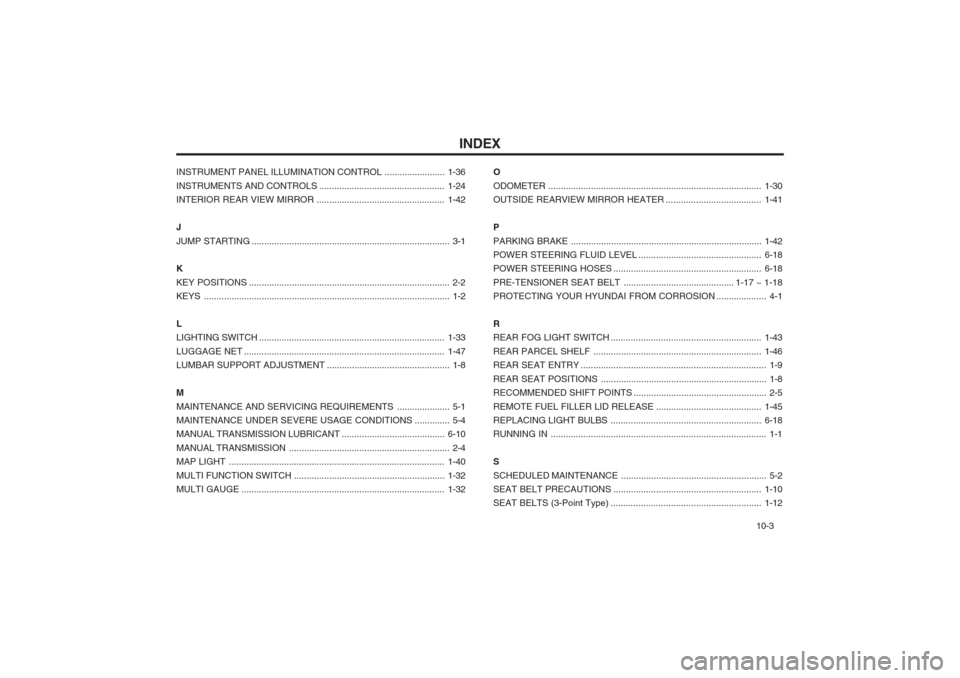
INDEX10-3
INSTRUMENT PANEL ILLUMINATION CONTROL
........................1-36
INSTRUMENTS AND CONTROLS ..................................................1-24
INTERIOR REAR VIEW MIRROR ...................................................1-42
J JUMP STARTING ............................................................................... 3-1
KKEY POSITIONS ................................................................................ 2-2
KEYS .................................................................................................. 1-2
L LIGHTING SWITCH .......................................................................... 1-33
LUGGAGE NET ................................................................................ 1-47
LUMBAR SUPPORT ADJUSTMENT ................................................. 1-8
M
MAINTENANCE AND SERVICING REQUIREM ENTS ..................... 5-1
MAINTENANCE UNDER SEVERE USAGE CONDITIONS .............. 5-4
MANUAL TRANSMISSION LUBRICANT .............. ...........................6-10
MANUAL TRANSMISSION ................................................................ 2-4
MAP LIGHT ...................................................................................... 1-40
MULTI FUNCTION SWITCH ................................ ............................1-32
MULTI GAUGE ................................................................................. 1-32OODOMETER
..................................................................................... 1-30
OUTSIDE REARVIEW MIRROR HEATER ...................................... 1-41
PPARKING BRAKE ............................................................................ 1-42
POWER STEERING FLUID LEVEL ................................................. 6-18
POWER STEERIN G HOSES ........................................................... 6-18
PRE-TENSIONER SEAT BELT ............................................ 1-17 ~ 1-18
PROTECTING YOUR HYUNDAI FROM CORROSION .................... 4-1
R
REAR FOG LIGHT SWITCH ............................................................ 1-43
REAR PARCEL SHELF ................................................................... 1-46
REAR SEAT ENTRY .......................................................................... 1-9
REAR SEAT POSITIONS .................................................................. 1-8
RECOMMENDED SHIFT POINTS ..................................................... 2-5
REMOTE FUEL FILLER LID RELEASE.......................................... 1-45
REPLACING LIGHT BULBS ................................. ...........................6-18
RUNNING IN ...................................................................................... 1-1
S SCHEDULED MAINTENANCE .......................................................... 5-2
SEAT BELT PRECAUTIONS ........................................................... 1-10
SEAT BELTS (3-Point Type) ............................................................ 1-12